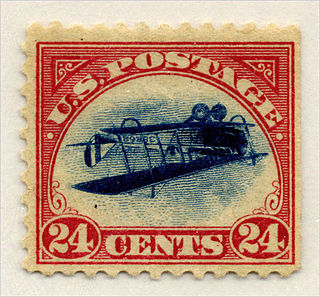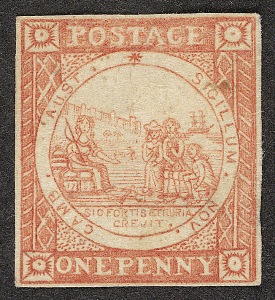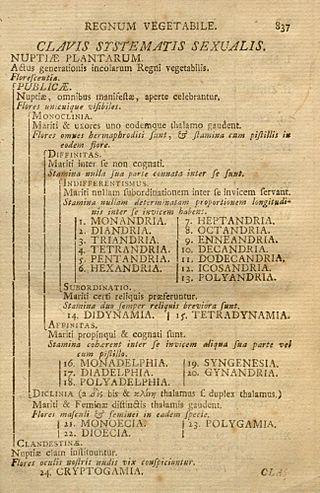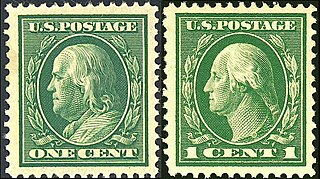
Philately is the study of postage stamps and postal history. It also refers to the collection and appreciation of stamps and other philatelic products. While closely associated with stamp collecting and the study of postage, it is possible to be a philatelist without owning any stamps. For instance, the stamps being studied may be very rare or reside only in museums.

Papermaking is the manufacture of paper and cardboard, which are used widely for printing, writing, and packaging, among many other purposes. Today almost all paper is made using industrial machinery, while handmade paper survives as a specialized craft and a medium for artistic expression.

A rotary printing press is a printing press in which the images to be printed are curved around a cylinder. Printing can be done on various substrates, including paper, cardboard, and plastic. Substrates can be sheet feed or unwound on a continuous roll through the press to be printed and further modified if required. Printing presses that use continuous rolls are sometimes referred to as "web presses".

In philately, errors, freaks, and oddities (EFO) collectively refer to the wide variety of mistakes that may occur during the production of postage stamps.

A paper machine is an industrial machine which is used in the pulp and paper industry to create paper in large quantities at high speed. Modern paper-making machines are based on the principles of the Fourdrinier Machine, which uses a moving woven mesh to create a continuous paper web by filtering out the fibres held in a paper stock and producing a continuously moving wet mat of fibre. This is dried in the machine to produce a strong paper web.

This is a survey of the postage stamps and postal history of New South Wales, a former British colony now part of Australia.

Security printing is the field of the printing industry that deals with the printing of items such as banknotes, cheques, passports, tamper-evident labels, security tapes, product authentication, stock certificates, postage stamps and identity cards. The main goal of security printing is to prevent forgery, tampering, or counterfeiting. More recently many of the techniques used to protect these high-value documents have become more available to commercial printers, whether they are using the more traditional offset and flexographic presses or the newer digital platforms. Businesses are protecting their lesser-value documents such as transcripts, coupons and prescription pads by incorporating some of the features listed below to ensure that they cannot be forged or that alteration of the data cannot occur undetected.

The British Central Africa Protectorate existed in the area of present-day Malawi between 1891 and 1907.

Wove paper is a type of paper first created centuries ago in the Orient, and subsequently introduced to England, Europe and the American colonies in the mid-eighteenth century. Hand-made wove paper was first produced by using a wooden mould that contained a finely-woven brass vellum, upon which the paper pulp was applied and dried, creating a smooth, uniform surface.

The history of postage stamps and postal history of Malaysia, a state in Southeast Asia that occupies the south of the Malay Peninsula and Sarawak and Sabah in the north Borneo, includes the development of postal services in these periods:

The postage stamps of Ireland are issued by the postal operator of the independent Irish state. Ireland was part of the United Kingdom of Great Britain and Ireland when the world's first postage stamps were issued in 1840. These stamps, and all subsequent British issues, were used throughout Ireland until the new Irish Government assumed power in 1922. Beginning on 17 February 1922, existing British stamps were overprinted with Irish text to provide some definitives until separate Irish issues became available within the new Irish Free State. Following the overprints, a regular series of definitive stamps was produced by the new Department of Posts and Telegraphs, using domestic designs. These definitives were issued on 6 December 1922, the day that the Irish Free State officially came into existence; the first was a 2d stamp, depicting a map of Ireland. Since then new images, and additional values as needed, have produced nine definitive series of different designs.

Laid paper is a type of paper having a ribbed texture imparted by the manufacturing process. In the pre-mechanical period of European papermaking, laid paper was the predominant kind of paper produced. Its use, however, diminished in the 19th century, when it was largely supplanted by wove paper. Laid paper is still commonly used by artists as a support for charcoal drawings.

Sheet metal embossing is a stamping process for producing raised or sunken designs or relief in sheet metal. This process can be made by means of matched male and female roller dies, or by passing sheet or a strip of metal between rolls of the desired pattern. It is often combined with foil stamping to create a shiny, 3D effect.

Philatelic expertisation is the process whereby an authority is asked to give an opinion whether a philatelic item is genuine and whether it has been repaired or altered in any way.

This is a survey of postage stamps and postal history of the German colonies and part of the postage stamps and postal history of Germany, as well as those of the individual countries and territories concerned.

Postage stamp paper is the foundation or substrate of the postage stamp to which the ink for the stamp's design is applied to one side and the adhesive is applied to the other. The paper is not only the foundation of the stamp but it has also been incorporated into the stamp's design, has provided security against fraud and has aided in the automation of the postal delivery system.

The Washington–Franklin Issues are a series of definitive U.S. Postage stamps depicting George Washington and Benjamin Franklin, issued by the U.S. Post Office between 1908 and 1922. The distinctive feature of this issue is that it employs only two engraved heads set in ovals—Washington and Franklin in full profile—and replicates one or another of these portraits on every stamp denomination in the series. This is a significant departure from previous definitive issues, which had featured pantheons of famous Americans, with each portrait-image confined to a single denomination. At the same time, this break with the recent past represented a return to origins. Washington and Franklin, after all, had appeared on the first two American stamps, issued in 1847, and during the next fifteen years, each of the eight stamp denominations available featured either Washington or Franklin.

The Halfpenny Yellow is the first postage stamp issued by the Crown Colony of Malta. Depicting Queen Victoria, it was only valid for local postage and it was originally issued on 1 December 1860. It was the only stamp issued by Malta for two and a half decades, and during this period various reprints were made with differences in colour shade, perforation and watermark. When control of Malta's postal service was transferred to the island's colonial government on 1 January 1885, the stamp was withdrawn and it was replaced by a set of definitive stamps.

The island of Cyprus first issued revenue stamps in 1878 and continues to do so to this day. The Turkish Republic of Northern Cyprus also issues its own revenue stamps.

Hong Kong issued revenue stamps from 1867 to the 1990s, both when it was a British colony as well as when it was under Japanese occupation.






















